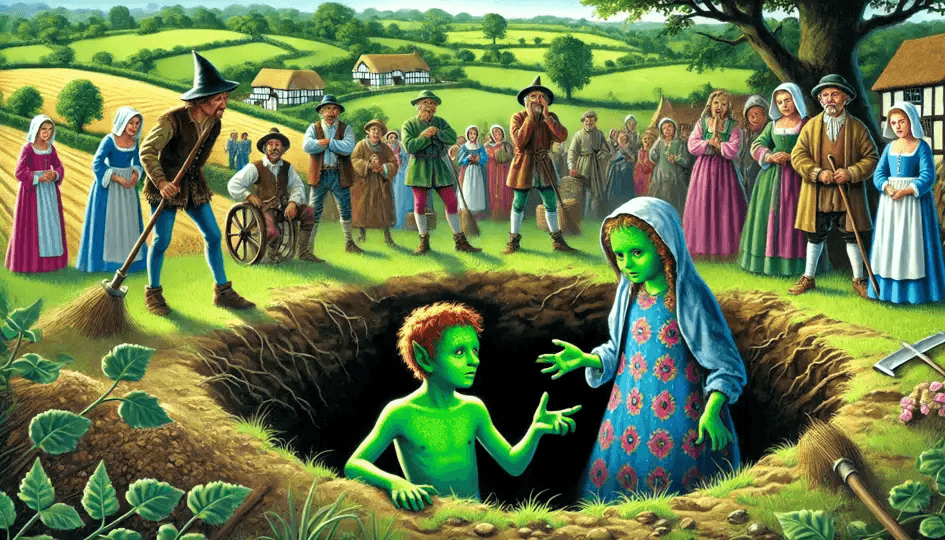
The Green Children of Woolpit: Visitors from a Hidden World?
🌱 A Strange Arrival in Suffolk
The tale begins in the rural village of Woolpit, Suffolk, during the reign of King Stephen (circa 1135–1154). Local harvesters were working in the fields when they discovered two young children—one boy and one girl—emerging from deep wolf-trapping pits that dotted the landscape. They were disoriented, terrified, and most astonishingly… green.
Chronicled by two reputable medieval historians, Ralph of Coggeshall and William of Newburgh, the incident was treated with unusual seriousness for the time. The children wore unfamiliar clothing made of an unknown material. They spoke no recognizable language. And despite being offered the village’s staple foods, they refused to eat anything except raw green beans for days.
Eventually, after being taken in by a local landowner, the children slowly adapted. They learned English. Their skin lost its green hue. The boy, weaker from the start, died within the first year. The girl, however, survived into adulthood—and it was then that she revealed her story.
🌘 The Land of St. Martin
According to the girl, she and her brother came from a place called “St. Martin’s Land”, where everything was green—people, animals, plants. It was a twilight world, without direct sunlight, existing in a kind of perpetual dusk. She claimed that they had been tending their father's livestock when they followed a strange sound through a tunnel or cave and suddenly found themselves in the bright light of Woolpit.
Scholars over the centuries have debated this cryptic description. Was this an allegory for a religious underworld? A misremembered traumatic migration from a foreign land? Or something entirely more bizarre?
👽 Extraterrestrial and Interdimensional Theories
Theories surrounding the Green Children are as varied as they are wild:
- Alien Hypothesis: Some ufologists suggest the children were extraterrestrials who accidentally arrived on Earth through a wormhole or interstellar gate. Their green skin, foreign language, and dietary needs could support this idea—especially if they came from a low-light biosphere.
- Interdimensional Travelers: Others propose they came from a parallel world or hidden dimension accessible through rare portals, like the cave they described. The “twilight” world might reference a different physical law or a misalignment in time-space itself.
- Feral Children from the Fens: A more grounded explanation is that the children were Flemish orphans fleeing persecution. The Fens of eastern England were dense and confusing, filled with marshes and underground channels. The green skin might have been caused by malnutrition, specifically hypochromic anemia, which was not understood in the Middle Ages.
🔍 The Plausible… and the Unexplained
Skeptics argue that the story was a garbled folk tale, with exaggerated details told over generations. But two independent chroniclers recorded it within a few decades of the event, lending the account some credibility.
Moreover, if the tale were a simple allegory or moral fable, it lacks the traditional medieval Christian themes—there is no punishment for sin, no divine resolution, only a lingering sense of mystery and otherness.
Historians have noted that green children legends appear in other parts of Europe, but few have the level of specific detail and historical documentation as the Woolpit case.
❓ Lingering Questions
- If they were aliens or interdimensional beings, why only those two?
- Why did they lose their green color with diet and sunlight?
- Could the language barrier have been more than linguistic—perhaps cognitive or dimensional?
Even today, Woolpit embraces the mystery. A village sign depicts the two green children, forever linked to a story that defies simple explanation.
The Enduring Mystery
The Green Children of Woolpit remain one of the most compelling historical anomalies of the Middle Ages. Whether folkloric exaggeration, misunderstood refugees, or genuine visitors from another world, their story continues to ignite the imagination of those who dare to question the boundaries of our known reality.
"Sometimes, legends are just history waiting to be decoded."